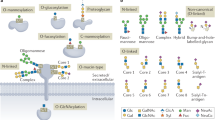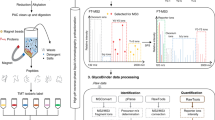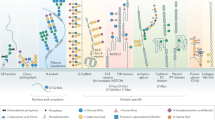Abstract
Mechanistic studies of O-GlcNAc glycosylation have been limited by an inability to monitor the glycosylation stoichiometries of proteins obtained from cells. Here we describe a powerful method to visualize the O-GlcNAc–modified protein subpopulation using resolvable polyethylene glycol mass tags. This approach enables rapid quantification of in vivo glycosylation levels on endogenous proteins without the need for protein purification, advanced instrumentation or expensive radiolabels. In addition, it establishes the glycosylation state (for example, mono-, di-, tri-) of proteins, providing information regarding overall O-GlcNAc site occupancy that cannot be obtained using mass spectrometry. Finally, we apply this strategy to rapidly assess the complex interplay between glycosylation and phosphorylation and discover an unexpected reverse 'yin-yang' relationship on the transcriptional repressor MeCP2 that was undetectable by traditional methods. We anticipate that this mass-tagging strategy will advance our understanding of O-GlcNAc glycosylation, as well as other post-translational modifications and poorly understood glycosylation motifs.
This is a preview of subscription content, access via your institution
Access options
Subscribe to this journal
Receive 12 print issues and online access
$259.00 per year
only $21.58 per issue
Buy this article
- Purchase on Springer Link
- Instant access to full article PDF
Prices may be subject to local taxes which are calculated during checkout




Similar content being viewed by others
References
Hanover, J.A., Krause, M.W. & Love, D.C. The hexosamine signaling pathway: O-GlcNAc cycling in feast or famine. Biochim. Biophys. Acta 1800, 80–95 (2009).
Rexach, J.E., Clark, P.M. & Hsieh-Wilson, L.C. Chemical approaches to understanding O-GlcNAc glycosylation in the brain. Nat. Chem. Biol. 4, 97–106 (2008).
Hart, G.W., Housley, M.P. & Slawson, C. Cycling of O-linked beta-N-acetylglucosamine on nucleocytoplasmic proteins. Nature 446, 1017–1022 (2007).
Dentin, R., Hedrick, S., Xie, J., Yates, J. III & Montminy, M. Hepatic glucose sensing via the CREB coactivator CRTC2. Science 319, 1402–1405 (2008).
Ngoh, G.A. et al. Unique hexosaminidase reduces metabolic survival signal and sensitizes cardiac myocytes to hypoxia/reoxygenation injury. Circ. Res. 104, 41–49 (2009).
Slawson, C. et al. Perturbations in O-linked beta-N-acetylglucosamine protein modification cause severe defects in mitotic progression and cytokinesis. J. Biol. Chem. 280, 32944–32956 (2005).
Tallent, M.K. et al. In vivo modulation of O-GlcNAc levels regulates hippocampal synaptic plasticity through interplay with phosphorylation. J. Biol. Chem. 284, 174–181 (2009).
Khidekel, N., Ficarro, S.B., Peters, E.C. & Hsieh-Wilson, L.C. Exploring the O-GlcNAc proteome: direct identification of O-GlcNAc–modified proteins from the brain. Proc. Natl. Acad. Sci. USA 101, 13132–13137 (2004).
Clark, P.M. et al. Direct in-gel fluorescence detection and cellular imaging of O-GlcNAc–modified proteins. J. Am. Chem. Soc. 130, 11576–11577 (2008).
Wang, Z. et al. Enrichment and site-mapping of O-linked N-acetylglucosamine by a combination of chemical/enzymatic tagging, photochemical cleavage, and electron transfer dissociation (ETD) mass spectrometry. Mol. Cell. Proteomics 9, 153–160 (2009).
Arnold, C.S. et al. The microtubule-associated protein tau is extensively modified with O-linked N-acetylglucosamine. J. Biol. Chem. 271, 28741–28744 (1996).
Dong, D.L., Xu, Z.S., Hart, G.W. & Cleveland, D.W. Cytoplasmic O-GlcNAc modification of the head domain and the KSP repeat motif of the neurofilament protein neurofilament-H. J. Biol. Chem. 271, 20845–20852 (1996).
Jackson, S.P. & Tjian, R. O-glycosylation of eukaryotic transcription factors: implications for mechanisms of transcriptional regulation. Cell 55, 125–133 (1988).
Lüthi, T., Haltiwanger, R.S., Greengard, P. & Bahler, M. Synapsins contain O-linked N-acetylglucosamine. J. Neurochem. 56, 1493–1498 (1991).
Roquemore, E.P. et al. Vertebrate lens alpha-crystallins are modified by O-linked N-acetylglucosamine. J. Biol. Chem. 267, 555–563 (1992).
Teo, C.F. et al. Glycopeptide-specific monoclonal antibodies suggest new roles for O-GlcNAc. Nat. Chem. Biol. 6, 338–343 (2010).
Wang, Z., Gucek, M. & Hart, G.W. Cross-talk between GlcNAcylation and phosphorylation: site-specific phosphorylation dynamics in response to globally elevated O-GlcNAc. Proc. Natl. Acad. Sci. USA 105, 13793–13798 (2008).
Dias, W.B., Cheung, W.D., Wang, Z. & Hart, G.W. Regulation of calcium/calmodulin-dependent kinase IV by O-GlcNAc modification. J. Biol. Chem. 284, 21327–21337 (2009).
Yang, X. et al. Phosphoinositide signalling links O-GlcNAc transferase to insulin resistance. Nature 451, 964–969 (2008).
Wells, L., Kreppel, L.K., Comer, F.I., Wadzinski, B.E. & Hart, G.W. O-GlcNAc transferase is in a functional complex with protein phosphatase 1 catalytic subunits. J. Biol. Chem. 279, 38466–38470 (2004).
Veronese, F.M. & Pasut, G. PEGylation, successful approach to drug delivery. Drug Discov. Today 10, 1451–1458 (2005).
Khidekel, N. et al. A chemoenzymatic approach toward the rapid and sensitive detection of O-GlcNAc posttranslational modifications. J. Am. Chem. Soc. 125, 16162–16163 (2003).
Ramakrishnan, B. & Qasba, P.K. Structure-based design of beta 1,4-galactosyltransferase I (beta 4Gal-T1) with equally efficient N-acetylgalactosaminyltransferase activity: point mutation broadens beta 4Gal-T1 donor specificity. J. Biol. Chem. 277, 20833–20839 (2002).
Holt, G.D. & Hart, G.W. The subcellular distribution of terminal N-acetylglucosamine moieties. Localization of a novel protein-saccharide linkage, O-linked GlcNAc. J. Biol. Chem. 261, 8049–8057 (1986).
Lamarre-Vincent, N. & Hsieh-Wilson, L.C. Dynamic glycosylation of the transcription factor CREB: a potential role in gene regulation. J. Am. Chem. Soc. 125, 6612–6613 (2003).
Davis, L.I. & Blobel, G. Nuclear pore complex contains a family of glycoproteins that includes p62: glycosylation through a previously unidentified cellular pathway. Proc. Natl. Acad. Sci. USA 84, 7552–7556 (1987).
Holt, G.D. et al. Nuclear pore complex glycoproteins contain cytoplasmically disposed O-linked N-acetylglucosamine. J. Cell Biol. 104, 1157–1164 (1987).
Fyffe, S.L. et al. Deletion of Mecp2 in Sim1-expressing neurons reveals a critical role for MeCP2 in feeding behavior, aggression, and the response to stress. Neuron 59, 947–958 (2008).
Khidekel, N. et al. Probing the dynamics of O-GlcNAc glycosylation in the brain using quantitative proteomics. Nat. Chem. Biol. 3, 339–348 (2007).
Marshall, S., Bacote, V. & Traxinger, R.R. Discovery of a metabolic pathway mediating glucose-induced desensitization of the glucose transport system. Role of hexosamine biosynthesis in the induction of insulin resistance. J. Biol. Chem. 266, 4706–4712 (1991).
Medina, L., Grove, K. & Haltiwanger, R.S. SV40 large T antigen is modified with O-linked N-acetylglucosamine but not with other forms of glycosylation. Glycobiology 8, 383–391 (1998).
Cheng, X., Cole, R.N., Zaia, J. & Hart, G.W. Alternative O-glycosylation/O-phosphorylation of the murine estrogen receptor beta. Biochemistry 39, 11609–11620 (2000).
Yang, W.H. et al. Modification of p53 with O-linked N-acetylglucosamine regulates p53 activity and stability. Nat. Cell Biol. 8, 1074–1083 (2006).
Mayr, B. & Montminy, M. Transcriptional regulation by the phosphorylation-dependent factor CREB. Nat. Rev. Mol. Cell Biol. 2, 599–609 (2001).
Carlezon, W.A. Jr., Duman, R.S. & Nestler, E.J. The many faces of CREB. Trends Neurosci. 28, 436–445 (2005).
Zhou, Z. et al. Brain-specific phosphorylation of MeCP2 regulates activity-dependent Bdnf transcription, dendritic growth, and spine maturation. Neuron 52, 255–269 (2006).
Tao, J. et al. Phosphorylation of MeCP2 at Serine 80 regulates its chromatin association and neurological function. Proc. Natl. Acad. Sci. USA 106, 4882–4887 (2009).
Tai, H.C., Khidekel, N., Ficarro, S.B., Peters, E.C. & Hsieh-Wilson, L.C. Parallel identification of O-GlcNAc–modified proteins from cell lysates. J. Am. Chem. Soc. 126, 10500–10501 (2004).
Acknowledgements
We thank the following people for their generous gifts: G. Hart (The Johns Hopkins University School of Medicine) for the OGT antibody, S. Whiteheart (University of Kentucky College of Medicine) for the OGA antibody, W. Wang and K. Hu (US National Institute of Aging) for the MeCP2 antibodies, P. Greengard and A. Nairn (The Rockefeller University) for the synapsin antibody and P. Qasba (US National Cancer Institute) for the Y289L GalT construct. We thank P. Clark and T. Wilson for a critical reading of the manuscript. We also thank P. Clark (California Institute of Technology) for preparing the Y289L GalT used in these studies and for contributing to the aminooxy-linker synthesis. This work was supported by grants from the US National Institutes of Health (R01 GM084724 to L.C.H.-W. and F31 NS056525-02 to J.E.R.) and the Rett Syndrome Research Foundation (Y.E.S.).
Author information
Authors and Affiliations
Contributions
J.E.R. and L.C.H.-W. conceived of and designed the experiments. J.E.R. performed the biochemistry and labeling experiments, J.T. and Y.E.S. contributed to the development and characterization of the phospho-specific antibody, C.J.R. synthesized and characterized the first set of aminooxy-functionalized PEG probes and S.-H.Y. synthesized the UDP-ketogalactose substrate and additional aminooxy-functionalized PEG probes. J.E.R. and L.C.H.-W. wrote the manuscript, and all authors participated in editing the manuscript.
Corresponding author
Ethics declarations
Competing interests
The authors declare no competing financial interests.
Supplementary information
Supplementary Text and Figures
Supplementary Methods, Supplementary Scheme 1 and Supplementary Figures 1–9. (PDF 3030 kb)
Rights and permissions
About this article
Cite this article
Rexach, J., Rogers, C., Yu, SH. et al. Quantification of O-glycosylation stoichiometry and dynamics using resolvable mass tags. Nat Chem Biol 6, 645–651 (2010). https://doi.org/10.1038/nchembio.412
Received:
Accepted:
Published:
Issue Date:
DOI: https://doi.org/10.1038/nchembio.412
This article is cited by
-
O-GlcNAcylation promotes pancreatic tumor growth by regulating malate dehydrogenase 1
Nature Chemical Biology (2022)
-
Loss of O-GlcNAcylation on MeCP2 at Threonine 203 Leads to Neurodevelopmental Disorders
Neuroscience Bulletin (2022)
-
Target protein deglycosylation in living cells by a nanobody-fused split O-GlcNAcase
Nature Chemical Biology (2021)
-
MYPT1 O-GlcNAc modification regulates sphingosine-1-phosphate mediated contraction
Nature Chemical Biology (2021)
-
Next-generation unnatural monosaccharides reveal that ESRRB O-GlcNAcylation regulates pluripotency of mouse embryonic stem cells
Nature Communications (2019)



